Swallowtails,festoons,Apollos,brushfoots
Marbled whites,graylings,ringlets,browns
Fritillaries
Whites,yellows,mimic sulphurs
Blues,coppers,hairstreaks
Blues,coppers,hairstreaks - interactive aid


| Deutsch / English | Home
and news Swallowtails,festoons,Apollos,brushfoots Marbled whites,graylings,ringlets,browns Fritillaries Whites,yellows,mimic sulphurs Blues,coppers,hairstreaks Blues,coppers,hairstreaks - interactive aid |
||||||
 |
 |
||||||
MARBLED WHITES, GRAYLINGS, RINGLETS and
BROWNS compared
|
|||||||
| home and news - sources - contact | |||||||
| 29 butterflies with "eyes" - respectively ocelli - at
a glance! The typical features are discribed with the help of
photos. Short outdoor videos make it easier to identify them. The species that are most likely to be encountered in Austria, Central Europe, are described in darker letters. The eastern and southern parts of Austria are warmer than the western, where you find mountains up to ~3800m (12500 feet) called Alps. |
 Send
this link by e-mail
Send
this link by e-mail |
|||||
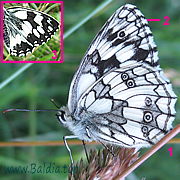 MARBLED WHITE MALE(video) (Melanargia galathea)Underside grey-black chequered pattern, (1), fringes strongly chequered (2). Upperside (3). Flies approx. mid May to mid Sep. Austria-wide on meadows up to 1800m (5900ft). |
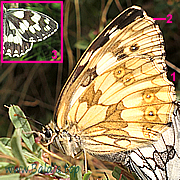 MARBLED WHITE FEMALE(video) (Melanargia galathea)Underside mustard colored chequered pattern, (1), fringes strongly chequered (2). Upperside (3). Flies approx. mid May to mid Sep. Austria-wide on meadows up to 1800m (5900ft). |
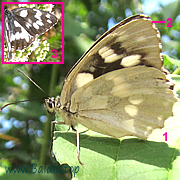 MARBLED WHITE LEUCOMELAS(video) (Melanargia galathea f. leucomelas)Underside hindwing light without pattern (1), otherwise checkerboard patterned, fringes strongly chequered (2). Upperside (3). Flies approx. Jun.-Jul. in warm eastern and southern Austria on meadows up to 1800m (5900ft). |
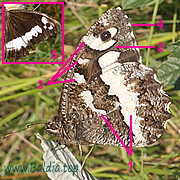 GREAT BRANDED GRAYLING(video)(Brintesia circe) Underside TWO white bands (1), forewing: white band is interrupted (2), forewing dark with three white marginal spots (3), fringes chequered (4). Upperside brown with interrupted white band (5). Flies approx. Jun.-Sep. widespread throughout Austria on bushy dry grass below 1700m (5600ft). |
|||
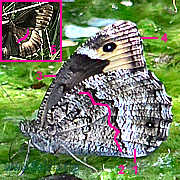 WOODLAND GRAYLING(video courtship )(Hipparchia fagi) Underside white mottled band (1), discalline slightly jagged (2), forewing dark, ocelli in beige-yellow band (3), fringes chequered (4). Upperside with light beige spots, hindwing: bright spots arranged in an arc (5). It is very similar to the Rock grayling, but larger and much more common . Flies approx. Jun.-Sep. throughout Austria on bushy meadows near forests rather below 1000m (3300ft). |
(Hipparchia alcyone)* |
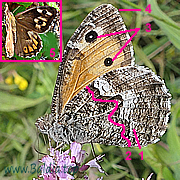 GRAYLING(video) (Hipparchia semele)Underside roughly mottled band (1), discalline with hihgh spike (2), forewing orange-yellow with TWO big ocelli (3), fringes chequered (4). Upperside brown with orange spots (5). Flies approx. Jun.-Sep. widespread troughout Austria near warm, dry bushy regions up to 2000m (6600ft). |
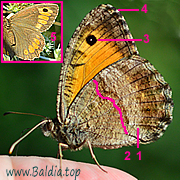 FALSE GRAYLING(video)(Arethusana arethusa) Underside roughly mottled pale band (1), discalline slightly wavy (2), forewing orange with ONE large and sometimes a second small ocellus (3), fringes chequered (4). Upperside brown with orange spots (5). Flies approx. Jul.-Sep. sporadically on warm, dry grasslands in eastern Austria up to 2000m (6600ft). |
|||
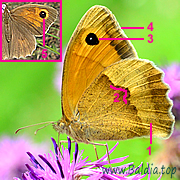 MEADOW BROWN FEMALE(video)(Maniola jurtina f.) Underside fine mottled light band (1), discalline with high spike (2), forewing orange, ONE ocellus in yellow band (3), fringes not chequered (4). Upperside forewing orange with a white centered ocellus (5). Flies approx. end of May-Sep. throughout Austria on high meadows up to 1600m (5200ft). |
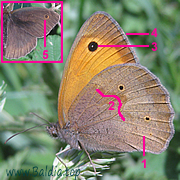 MEADOW BROWN MALE(video)(Maniola jurtina m.) Underside fine mottled pale band (1), blasse discalline with high spike (2), forewing orange with ONE ocellus (3), fringes not chequered (4). Upperside brown with an ocellus mostly white centered (5). Flies approx. end of May-Sep. throughout Austria on high meadows up to 1600m (5200ft). |
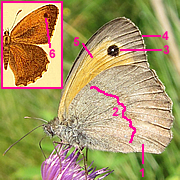 DUSKY MEADOW BROWN MALE(Hyponephele lycaon m.)*Underside fine mottled pale band (1), discalline slightly wavy (2), forewing orange with ONE ocellus (3), fringes hardly chequered (4), forewing without discalline (5). Upperside upperside forewing pale orange with an ocellus NOT white centered (6). Flies approx. Jun.-Aug. locally in eastern and southern Austria on bushy, rocky meadows up to 2100m (6900ft). |
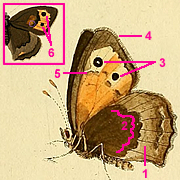 DUSKY MEADOW BROWN FEMALE(Hyponephele lycaon f.)*Underside fine mottled pale band (1), discalline slightly wavy (2), forewing orange with TWO ocelli (3), fringes hardly chequered (4), forewing with discalline (5). Upperside forewing brown-orange, two ocelli NOT white centered in orange band (6). Flies approx. Jun.-Aug. locally in eastern and southern Austria on bushy, rocky meadows up to 2100m (6900ft). |
|||
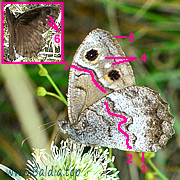 TREE GRAYLING MALE(video) (Hipparchia statilinus)Underside mottled gray and light band (1), distinct discalline jagged (2), forewing gray with gray-white discalstripe (3), forewing: TWO WHITE DOTS between the large ocelli rurrounded by yellow (4), forewing-fringes chequered (5). Upperside brown, on the forewing two white dots between the dark ocelli (6). Flies approx. Jul.-Oct. in warm, dry, rocky places in eastern and southern Austria up to 1400m (4600ft) and is rare. |
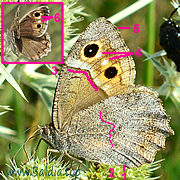 TREE GRAYLING FEMALE(video) (Hipparchia statilinus)Underside grey-brown mottled and possiblya light band (1), pale discalline jagged (2), forewing grey-brown with brown-white discalstripe (3), forewing: TWO WHITE DOTS betwenn the large ocelli surrounded by yellow (4), forewing-fringes chequered (5). Upperside brown, on the forewing two white dots between the orange ringed ocelli (6). Flies approx. Jul.-Oct. in warm, dry, rocky places in eastern and southern Austria up to 1400m (4600ft) and is rare. |
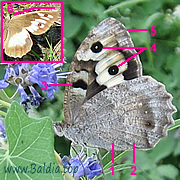 THE HERMIT FEMALE(video)(Chazara briseis f.) Underside mottled beige-grey (1), very pale band (2), grey-beige, high-contrast forewing with a conspicuous dark spot (3), two forewing-ocelli in light band (4), forewing-fringes lightly chequered (5). Upperside brown with white spots and light forewing edge (6). Flies approx. Jul.-Oct. in warm, dry, rocky places in eastern and southern Austria below 2000m (6600ft) and is rare. |
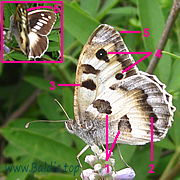 THE HERMIT MALE(video)(Chazara briseis m.) Underside light beige with two brown spots (1), brownish band postdiscal (2), bright, high-contrast forewing with a conspicuous dark spot (3), two forewing-ocelli in light band (4), forewing-fringes lightly chequered (5). Upperside brown with white spots and light forewing edge (6). Flies approx. Jul.-Oct. in warm, dry, rocky places in eastern and southern Austria below 2000m (6600ft) and is rare. |
|||
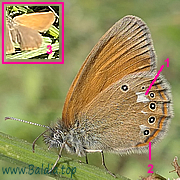 CHESTNUT HEATH(video) (Coenonympha glycerion) small, Underside some white spots postdiscal on mustard gray wing (1), orange-grey marginal stripes (2). Upperside (rarely seen) orange and brown (3). Flies approx. Jun.-Aug. throughout Austria on bushy meadows below 1800m (5900ft). |
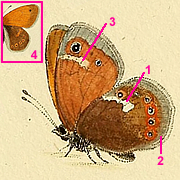 LARGE HEATH(Coenonympha tullia)*Underside scattered white spots on mustard gray wing (1), WITHOUT marginal stripe (2), white line on forewing (3). Upperside orange and brown (4). Flies approx. Jun.-Aug. rather northern Austria near swamps below 1200m (3900ft). |
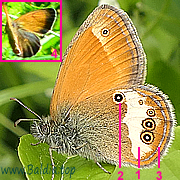 PEARL HEATH(video) (Coenonympha arcania)Underside wide, continuous, white band with adjacent conspicuous ocelli (1), first ocellus offset basally (2), orange-grey marginal stripe (3). Upperside (rarely seen) orange-brown (4). Flies approx. Jun.-Oct. throughout Austria on bushy meadows up to 1800m (5900ft). |
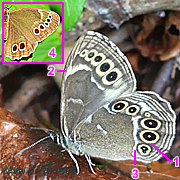 WOODLAND BROWN(video)(Lopinga achine) Very rare. Underside remarkably large, yellow-rimmed ocelli (1), yellow line on the fore-wing (2), white band on the hindwing (3). Upperside brown with large ocelli ringed with yellow (4). Flies approx. Jun.-Aug. Austria-wide near semi-shady edge of forest at 200-1500m (660-4900ft). |
|||
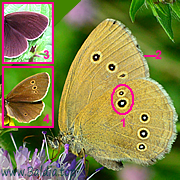 RINGLET(video)(Aphantopus hyperantus) Underside two of five ocelli offset basally , on brown hindwing (1), very LIGHT fringes (2). Upperside male brown with small ocelli (3). Upperside female brown with larger ocelli (4). Flies approx. Jun.-Sep. Austria-wide on meadows near the forest up to 1600m (5200ft). |
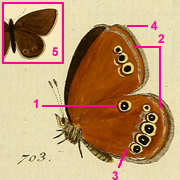 FALSE RINGLET(Coenonympha oedippus)*Underside first ocellus offset basally (1), silver marginal stripe (2), narrow light stripe under the ocelli (3), fringes not chequered (4). Upperside brown and hardly any ocelli (5). Flies approx. Jun.-Jul. in wet areas of north-eastern Austria at 150-500m (500-1600ft) and is very rare. |
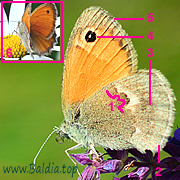 SMALL HEATH(video) (Coenonympha pamphilus)Small. Underside (often pale) discalline with two arches on grey-beige wing (1), NO marginal stripe (2), sometimes small, white centered ocelli postdiscal (3), forewing ocellus with ONE white pupil (4), fringes not chequered (5). Upperside orange-yellow with an ocellus (rather females) or without an ocellus (rather males) (6). Flies approx. Apr.-Oct. Austria-wide on meadows up to 2000m (6600ft). |
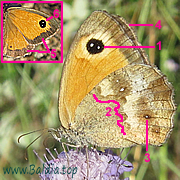 GATEKEEPER(Pyronia tithonus)Small. forewing ocellus with TWO white pupils (1), discalline wavy (2), sometimes small, white pupilled ocelli postdiscal (3), fringes lightly checkered (4). Upperside orange with a wide brown border (5), top of forewing ocellus with TWO white pupils (6). Flies approx. Jun.-Sep. in western and southern Europe (and possibly not in Austria) near moist coniferous forests up to 1700m (5600ft). |
|||
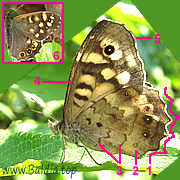 SPECKLED WOOD(video) (Pararge aegeria)Underside mottled orange or brown with pointed wing edges (1), ea row of inconspicuous ocelli on the hindwing (2), jagged transverse lines (3), forewing with conspicuous tiger pattern (4), fringes chequered (5). Upperside brown, on forewing orange-beige spots and one ocellus, and on hindwing a row of ocelli (6). Flies approx. Mar.-Oct. Austria-wide at a semi-shady edge of a forest up to 1500m (4900ft). |
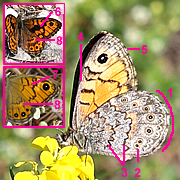 WALL BROWN(video female, video male) (Lasiommata megera)Underside mottled brown-grey with rounded wing edge (1), ordered row of ocelli (2), arcaded transverse lines (3), forewing orange after narrow, brownish front stripe (4), fringes chequered (5). Upperside forewing male discal orange with thick line (6). Upperside forewing female discal orange (7). Upperside hindwing discal an orange band, and a row of ocelli in another orange band (8). Flies approx. Apr.-Oct. throughout Austria on stony meadows up to 2300m (7500ft). |
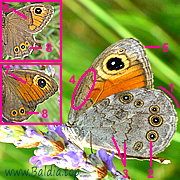 LARGE WALL BROWN(video) (Lasiommata maera)Underside mottled brown-grey with rounded wing edge (1), ordered row of ocelli (2), arcaded transverse lines (3), forewing orange after broad, gray front stripe (4), fringes chequered (5). Upperside forewing male discal brown (6). Upperside forewing female discal orange (7). Upperside hindwing WITHOUT discal line, a row orange ocelli (8). Flies approx. May-Oct. throughout Austria on dry, stony edge of a forest up to 2000m (6600ft). |
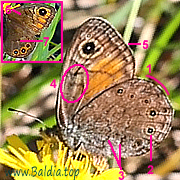 NORTHERN WALL BROWN(video) (Lasiommata petropolitana)Underside mottled dark-brown with rounded wing edge (1), ordered row of ocelli (2), arcaded transverse lines (3), forewing orange after broad, brown front stripe (4), fringes chequered (5). Upperside forewing discal brown (male and female) (6). Upperside hindwing WITH discal line, a row orange ocelli (7). Flies approx. May-Aug. throughout Austria on stony edge of forest 400-1200m (1300-3900ft). |
|||
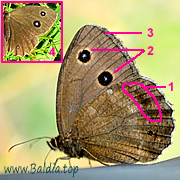 DRYAD(video male, video female) (Minois dryas)Underside dark band submarginal (1), forewings dark with two large ocelli ringed yellow and centered blue-white (2), fringes chequered (3). Upperside brown, two large blue-white pupilled ocelli on the forewing (4). Flies approx. Jul.-Sep. Austria-wide on bushy meadows at 100-1600m (500-5200ft). |
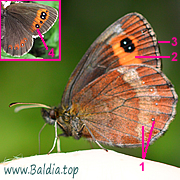 SCOTCH ARGUS(video male, video female)(Erebia aethiops) Underside gray band sometimes with small, white-pupilled ocelli (1), forewing brown, ocelli in orange band (2), few chequered, gray fringes (more females) (3). Upperside brown upperside, white pupilled ocelli in orange band (4). Flies approx. Jul.-Sep. throughout Austria on flowery pine forest clearings at 300-1500m (1000-4900ft). |
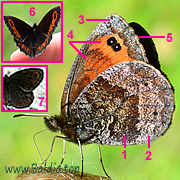 WATER RINGLET(video) (Erebia pronoe)Underside heavily mottled, dark discal-band (1), light band (slightly shimmering violet in males) (2), tip of forewing light mottled (3), forewing orange-brown, ocelli in orange band (4), fringes lightly chequered in wing color (5). Upperside*4 brown, pattern variable (6,7). Flies approx. Jul.-Sep. common in the Alps near springs at 900-2800m (3000-9200ft). |
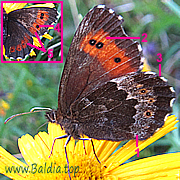 LARGE RINGLET(Erebia euryale)Underside light band (darker in males) (1), forewing brown, ocelli in orange band (2), heavily black and white chequered fringes (3). Upperside brown, small ocelli almost WITHOUT white pupil (4), forewing ocelli in orange band and hindwing ocelli in single orange dots (5). Flies approx. Jul.-Sep. widespread in the Alps in flowery coniferous forest clearings at 750-2500m (2500-8200ft). |
|||
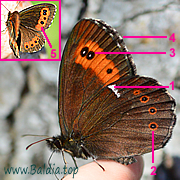 ARRAN BROWN(video) (Erebia ligea)Underside characteristic white spots on brown wing (1), single orange ringed ocelli (2), forewing brown, ocelli in orange band (3), heavily chequered fringes (4). Upperside brown, forewing ocelli with white pupil in an orange band (5). Flies approx. Jul.-Sep. throughout Austria in forest clearings up to 1800m (5900ft). |
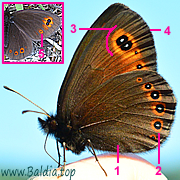 WOODLAND RINGLET(video)(Erebia medusa) Underside brown (1), some orange ringed ocelli (2), forewing brown, roundish orange ocelli (3), dark fringes (4). Upperside brown, white pupilled ocelli in single orange dots (5). Flies early approx. May-Jul. Austria-wide near ferny forests 300-2300m (1000-7500ft). |
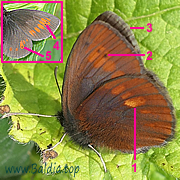 YELLOW SPOTTED RINGLET MALE(video) (Erebia manto)Underside few orange-yellow spots (1), forewing brown with orange spots and few, very small, black ocelli WITHOUT white pupil (2), dark fringes not chequered (3), Upperside forewing brown with orange spots and very small, black ocelli WITHOUT white pupil (4), hindwing brown and few orange spots (5). Flies approx Jul.-Aug. widespread in the Alps in high meadows at 1200-2500m (3900-8200ft). |
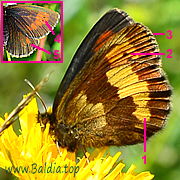 YELLOW SPOTTED RINGLET FEMALE(video) (Erebia manto)Underside yellow band (1), forewing reddish with orange band and few, very small, black ocelli WITHOUT white pupil (2), fringes not chequered (3). Upperside forewing brown with orange spots and very small, black ocelli WITHOUT white pupil (4), hindwing brown and few orange spots (5). Flies approx.Jul.-Aug. widespread in the Alps in high meadows at 1200-2500m (3900-8200ft). |
|||
| The Satyrinae are a subfamily of the
Nymphalidae. They used to be considered a separate family called
Satyridae. The identification aid for Satyrinae was created on March 17, 2022. * The marked images with an asterisk are watercolors of E. J. C. Esper (1829-1839), J. F. W. Herbst (1783-1804), J. Hübner ( 1805) and A. Spuler (1910) or symbol pictures. The affiliation can be seen from the respective file name. |
||||||
| home and news - sources - contact | ||||||
Appendix with designations |
||
| {la} SATYRINAE | {de} AUGENFALTER | MARBLED WHITES, GRAYLINGS, RINGLETS, BROWNS |
| {la} Lopinga achine (Scopuli, 1763), L.
deianira (Linnaeus, 1764). Weitere Namen (W. F. Kirby ,1871): Satyrus dejanira (Linnaeus, 1764), Papilio achine (Scopoli, 1763). |
{de} Gelbringfalter, Bacchantin | {en} Woodland brown {es} Lopinga achine {fr} Bacchante {it} Mera dei boschi {sk} Scopolijev zlatook {sv} Dårgräsfjäril |
| {la} Pararge aegeria (Linnaeus, 1758),
P. vulgaris (Zeller, 1847). Weitere Namen (W. F. Kirby ,1871): Satyrus / Papilio aegeria (Linnaeus, 1767), Satyrus Xiphia m. (Herrich-Schäffer, 1843-1844). |
{de} Waldbrettspiel, Laubfalter | {en} Speckled wood {es} Maculada, mariposa de los muros u ondolada {fr} Tircis {it} Egeria {sk} Gozdni pegavček {sv} Kvickgräsfjäril |
| {la} Erebia aethiops (Esper, 1777). Weitere Namen (W. F. Kirby ,1871): Maniola medea (Denis und Schiffermüller, 1776), Papilio aethiops (Esper, 1777?), Papiliio blandina (Fabricius, 1787), Papiliio alcyone (Stewart, 1817), Papilio medusa (Borkhausen, 1788), Hipparchia neoridas (Dalman, 1832). |
{de} Graubindiger Mohrenfalter, Waldteufel, Trockenrasenwald-Mohr, Wald-Mohrenfalter | {en} Scotch argus {es} Erebia aethiops {fr} Moiré sylvicole, le Moiré tardif {it} Etiope {sk} Gozdni rjavček {sv} Hundäxingfjäril |
| {la} Hipparchia alcyone (Denis und
Schiffermüller, 1775), Epitheton alcyone (Denis und Schiffermüller,
1775), Hipparchia aelia (Hoffmannsegg, 1804), Hipparchia hermione
(Linnaeus, 1763). Weitere Namen (W. F. Kirby ,1871, p. 86): Nymphalis hermione minor (Esper, 1777), Papilio hermiona (Herbst, 1796), Papilio jurtiua (Hufnagel, 1766). |
{de} Kleiner Waldportier | {en} Rock grayling {es} banda acodada {fr} Petit Sylvandre {it} Hipparchia alcyone {sk} Hipparchia alcyone {sv} Liten bandgräsfjäril |
| {la} Coenonympha arcania (Linnaeus,
1761). Weitere Namen (W. F. Kirby ,1871): Papilio amyntas (Scopoli, 1763), Papilio cephalus (Fourcroy, 1785). |
{de} Perlgrasfalter, Weißbindiges Wiesenvögelchen | {en} Pearly heath {es} Coenonympha arcania {fr} Céphale {it} Arcania {sk} Grmiščni okarček {sv} Pärlgräsfjäril |
| {la} Arethusana arethusa (Denis und
Schiffermüller, 1775). Weitere Namen (W. F. Kirby ,1871): Hipparchia / Papilio arethusa (Denis und Schiffermüller, 1775), Satyrus arethusa (Godart, 1823), Satyrus arethusa v. boabdil (Herrich-Schäffer, 1850?), Hipparchia arethusa (Freyer, 1852). |
{de} Rotbindiger Samtfalter, Rotbindensamtfalter /td> | {en} False grayling {es} Pintas ocres {fr} Mercure, Petit Agreste {it} Aretusa {sk} Okrasti košeničar {sv} Falsk sandgräsfjäril |
| {la} Chazara briseis (Linnaeus, 1764). Weitere Namen (W. F. Kirby ,1871): Hipparchia / Papilio briseis (Linnaeus, 1764), Satyrus briseis (Godart, 1823), Papilio ianthe (Pallas, 1771), Papilio daedale (Bergsträsser, 1780). |
{de} Berghexe, Steintrift-Samtfalter, Felsenfalter, Steppenpförtner, Blaugras-Augenfalter | {en} Hermit {es} Chazara briseis {fr} Hermite {it} Briseide {sk} Skalni puščavar {sv} Vitbandad gräsfjäril |
| {la} Brintesia circe (Fabricius, 1775),
Kanetisa circe (Fabricius, 1775), Brintesia proserpina (Denis und
Schiffermüller, 1775), Aulocera circe (Fabricius, 1775). Weitere Namen (W. F. Kirby ,1871): Papilio circe (Fabricius, 1775), Satyrus circe (Godart, 1823), Papiliio proserpina (Denis und Schiffermüller, 1776). |
{de} Weißer Waldportier |
{en} Great banded grayling {es} Brintesia circe {fr} Silène {it} Circe {sk} Travnar {sv} Stor vitbandad gräsfjäril |
| {la} Minois dryas (Scopuli, 1763), M.
phaedra (Linnaeus, 1764). Weitere Namen (W. F. Kirby ,1871): Hipparchia / Papilio phaedra (Linnaeus, 1764), Satyrus phaedra (Godart, 1823), Papilio dryas (Scopoli, 1763), Nymphalis briseis (Esper, 1777), Papiliio athene (Borkhausen, 1788). |
{de} Blaukernauge, Blauäugiger Waldportier, Riedteufel, Blauauge, Wiesenhaferfalter, Blauauge | {en} Dryad {es} Ocelos azules {fr} Grand Nègre des bois {it} Driade {sk} Žametni modrook {sv} Blåfläckad gräsfjäril |
| {la} Erebia euryale (Eser, 1805). Weitere Namen (W. F. Kirby ,1871): Maniola / Satyrus / Hipparchia / Erebia euryale, Hipparchia ligea m. (Stephens, 1827), ?Papilio philomela (Esper, 1800?). |
{de} Weißbindiger Bergwald-Mohrenfalter | {en} Large ringlet {es} Montañesa ribeteada {fr} Moiré frange-pie {it} Euriale {sk} Svetlolisi rjavček {sv} Liten skogsgräsfjäril |
| {la} Hipparchia fagi (Scopuli,
1763). Weitere Namen (W. F. Kirby ,1871, p. 86): Hipparchia hermione, Papilio hermione (Linnaeus, 1764), Nymphalis hermione major (Esper, 1772), Pap. fagi (Scopoli, 1763), Pap. velleda (Rottemburg, 1775). |
{de} Großer Waldportier |
{en} Woodland grayling {es} Hipparchia fagi {fr} Sylvandre {it} Ipparchia del faggio {sk} Veliki gozdnik {sv} Stor bandgräsfjäril |
| {la} Melanargia galathea (Linnaeus,
1758). Weitere Namen (W. F. Kirby ,1871): Papilio galathea (Esper, 1800), Satyrus galathea (Godart, 1823), Papilio Liriope (Cyrilli, 1787). |
{de} Schachbrett, Schachbrettfalter, Damenbrett, Brettspiel | {en} Marbled white {es} Medioluto norteña {fr} Demi-deuil {it} Galatea {sk} Travniški lisar {sv} Schackbräde |
| {la} Coenonympha glycerion (Borkhausen,
1788). Weitere Namen (W. F. Kirby ,1871): C. iphis (Wien Verz, 1776), Papilio tiphon (Esper, 1779?), Papilio hero (Fabricius, 1793), Maniola manto (Schrank, 1801), w. Papilio amyntas (Poda, 1761), Coenonympha mandane (Kirby, 1862). |
{de} Rotbraunes Wiesenvögelchen, Rostbraunes Wiesenvögelchen | {en} Chestnut heath {es} Coenonympha glycerion {fr} Iphis, Fadet de la mélique {it} Ninfa orientale {sk} Belolisi okarček {sv} Darrgräsfjäril |
| {la} Aphantopus hyperantus (Rottemburg,
1775). Weitere Namen (W. F. Kirby ,1871): Hipparchia hyperanthus / Papilio hyperantus (Linnaeus, 1761), Danaus hyperanthus (Esper, 1777), Satyrus hyperanthus (Godart, 1823), Papilio polymeda (Scopoli, 1763). |
{de} Brauner Waldvogel, Schornsteinfeger, Weißrandiger Mohrenfalter, Hirsengrasfalter | {en} Ringlet {es} Sortijitas {fr} Tristan {it} Tristano {sk} Okati rjavec {sv} Luktgräsfjäril |
| {la} Maniola jurtina (Linnaeus, 1758). Weitere Namen (W. F. Kirby ,1871): Epinephile/Papilio jurtina (Linnaeus, 1761), Papilio janira (Linnaeus, 1761), Sat. jurtina (Godart, 1823), Papilio pamphilus (Hufnagel, 1766), Maniola lemur (Schrank, 1801). |
{de} Großes Ochsenauge, Kuhauge | {en} Meadow brown {es} Maniola jurtina {fr} Myrtil {it} Maniola comune {sk} Navadni lešnikar {sv} Slåttergräsfjäril |
| {la} Erebia ligea (Linnaeus, 1758). Weitere Namen (W. F. Kirby ,1871):Papilio alexis (Esper, 1780), Erebia eumonia (Ménétries, 1859). |
{de} Weißbindiger Mohrenfalter, Milchfleck, Waldmohrenfalter , Großer Mohrenfalter, Rostbindiger Mohrenfalter, Waldhochgrasflur-Weißsprenkelmohr, Weißband-Mohrenfalter | {en} Arran brown {es} Arrán marrón {fr} Moiré blanc-fascié, Moiré fascié {it} Ligea {sk} Belolisi rjavček {sv} Skogsgräsfjäril |
| {la} Hyponephele lycaon (Rottemburg,
1775). Weitere Namen (W. F. Kirby ,1871, p. 76f.): Epinephile lycaon (Kühn, 1774), Papilio eudora (Esper, 1774), Pap. jurtina (hübner, 1794?), Hipparchia rhamnusia (Freyer, 1845). |
{de} Kleines Ochsenauge | {en} Dusky meadow brown {es} Hyponephele lycaon {fr} Lycaon, Misis {it} Licaone {sk} Grmovni oblakar {sv} Gråbrun slåttergräsfjäril |
| {la} Erebia manto (Denis und
Schiffermüller, 1775). Weitere Namen (W. F. Kirby ,1871): Maniola manto (Denis und Schiffermüller, 1775), Papilio lappona (Thunberg, 1791), Papilio zilia (Borkhausen, 1789), Papilio pandrosus (Borkhausen, 1788), Papilio dubius (Fuessly, 1783), Papilio aglaurus (Herbst, 1796), Maniola baucis (Schrank, 1801). |
{de} Gelbgefleckter Mohrenfalter | {en} Yellow-spotted ringlet
{es} Montañesa uniforme {fr} Moiré variable {it} Manto {sk} Rumenolisi rjavček {sv} Gulfläckig svartgräsfjäril |
| {la} Lasiommata maera (Linnaeus, 1758),
L. hiera (Fabricius, 1777), L. monotonia (Schneider, 1885). Weitere Namen (W. F. Kirby ,1871): Satyrus / Papilio maera (Linnaeus, 1761), Amecera maera (Butler, 1868), Satyrus adrasta (Duponchel, 1832). |
{de} Braunauge, Rispenfalter | {en} Large wall brown {es} Mariposa pedregosa {fr} le Némusien (m.), l'Ariane (f.) {it} Mera {sk} Veliki skalnik {sv} Vitgräsfjäril |
| {la} Erebia medusa (Denis und
Schiffermüller, 1775). Weitere Namen (W. F. Kirby ,1871): Papilio medusa (Denis und Schiffermüller, 1776), Satyrus medusa (Godart, 1823), Papilio ligea (Esper, 1777), Papilio themistocles (De Loche, 1801), Erebia embla (herrich-Schäffer, 1847-1850), Hipparchia medusa (Eversmann, 1844). |
{de} Rundaugen-Mohrenfalter, Blutgrasfalter, Früher Mohrenfalter, Mohrenfalter, Frühlings-Mohrenfalter | {en} Woodland ringlet {es} Erebia medusa {fr} Moiré franconien, Franconien {it} Medusa {sk} Pomladni rjavček {sv} Medusas svartgräsfjäril |
| {la} Lasiommata megera (Linnaeus,
1767). Weitere Namen (W. F. Kirby ,1871): Satyrus / Papilio megaera (Linnaeus, 1767), Papilio maera (Hufnagel, 1766). |
{de} Mauerfuchs |
{en} Wall brown {es} Mariposa saltacercas {fr} Satyre (m.), Mégère (f.) {it} Megera {sk} Okrasti skalnik {sv} Svingelgräsfjäril |
| {la} Coenonympha oedippus (Fabricius,
1787). Weitere Namen (W. F. Kirby ,1871): Papilio / Satyrus oedippus, Papilio iphigenus (Herbst, 1796), Papilio pylarge (Hübner, 1798). |
{de} Moor-Wiesenvögelchen, Verschollenes Wiesenvögelchen, Stromtal-Wiesenvögelchen | {en} False ringlet {es} Coenonympha oedippus {fr} Oedippe, Fadet des laîches {it} Ninfa dei fontanili {sk} Barjanski okarček {sv} Falsk luktgräsfjäril |
| {la} Coenonympha pamphilus (Linnaeus,
1758). Weitere Namen (W. F. Kirby ,1871): Papilio menalcas (Poda, 1761), Papilio gardetta (De Loche, 1801), Papilio pamphila (Hübner 1800-1823). |
{de} Kleines Wiesenvögelchen, Kleiner Heufalter, Gemeines Wiesenvögelchen, Kälberauge, Kleines Gelbes Wiesenvögelchen, Kleiner Heugrasfalter | {en} Small heath {es} Coenonympha pamphilus {fr} Procris, Fadet commun {it} Ninfa minore {sk} Mali okarček {sv} Kamgräsfjäril |
| {la} Lasiommata petropolitana
(Fabricius, 1787). Weitere Namen (W. F. Kirby ,1871): Satyrus / Papilio hiera (Fabricius, 1777). |
{de} Braunscheckauge, Kleines Braunauge | {en} Northern wall
brown {es} Lasiommata petropolitana {fr} Gorgone {it} Mera dei monti {sk} Planinski skalnik {sv} Berggräsfjäril |
| {la} Erebia pronoe (Esper, 1780). Weitere Namen (W. F. Kirby ,1871): Papilio arachne (Hübner, 1795-1798), Sat. neoridas (Boisduval, 1829), Hipparchia stygne (Fischer, 1820). |
{de} Quellen-Mohrenfalter, Wasser-Mohrenfalter | {en} Water ringlet {es} Erebia pronoe {fr} Moiré fontinal {it} Pronoe {sk} Temni rjavček {sv} Violettbandad svartgräsfjäril |
| {la} Hipparchia semele (Linnaeus,
1758). Weitere Namen (W. F. Kirby ,1871): Papilio semele (Linnaeus, 1761) (Hübner, 1826?), Satyrus semele (Godart, 1823), Papilio danae (Hufnagel, 1766). |
{de} Ockerbindiger Samtfalter, Rostbinde, Samtbinde, Ockersamtfalter, Ockerbindiger Sammetfalter | {en} Grayling {es} Pardo rubia, sátiro común {fr} Agreste {it} Semele {sk} Rjasti gozdnik {sv} Sandgräsfjäril |
| {la} Hipparchia statilinus (Hufnagel, 1766),weitere Namen (W. F. Kirby ,1871): Papilio arachne (Wien. Verz., 1776), Papilio fauna (Sulzer, 1776), Papilio fidia (Esper, 1780), Papilio allionius (herbst, 1796), Papilio actaea (De Vill., 1789) | {de} Eisenfarbiger Samtfalter, Kleine Rostbinde, Eisenfarbener Samtfalter | {en} Tree grayling {es} Hipparchia statilinus {fr} Faune {it} Fauno {sk} Primorski gozdnik {sv} Liten trädgräsfjäril |
| {la} Pyronia tithonus (Linnaeus, 1771). Weitere Namen (W. F. Kirby ,1871): Papilio tithonus (Linnaeus, 1771) (Herbst, 1796), Papilio tiphon (Kühn, 1774), Papilio pilosellae (Fabricius, 1775), Papilio herse (Denis und Schiffermüller, 1776), Papilio phaedra (Esper, 1777), Papilio amaryllis (Borkhausen, 1788), Satyrus amaryllis (Godart, 1822). |
{de} Rotbraunes Ochsenauge, Rostbraunes Ochsenauge, Gelbes Ochsenauge, Braungerändertes Ochsenauge | {en} Gatekeeper {es} Lobito jaspeado {fr} Amaryllis {it} Pyronia tithonus {sk} Temna ognjenka {sv} Buskgräsfjäril |
| {la} Coenonympha tullia (Müller, 1764). Weitere Namen (W. F. Kirby ,1871): Coenympha / Papilio typhon (Rottenburg, 1775), ? Papilio tullia (Müller, 1764), Papilio hero (Lewis, 1795), Coenympha davus, va. Rothliebi (Staudinger, 1861), Papilio musarion (Borkhausen, 1788), Papilio polymeda (Jermyn, 1827), Hipparchia demophile (Freyer, 1844?). |
{de} Großes Wiesenvögelchen, Großer Heufalter, Großer Heugrasfalter | {en} Large heath {es} Coenonympha tullia {fr} Fadet des tourbières, Daphnis {it} Tullia {sk} Munčev okarček {sv} Starrgräsfjäril |
| contact | ||